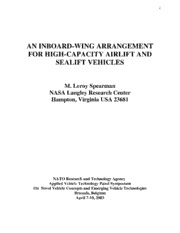
An Inboard-Wing Arrangement for High-Capacity Airlift and Sealift Vehicles PDF
Preview An Inboard-Wing Arrangement for High-Capacity Airlift and Sealift Vehicles
1 AN INBOARD-WING ARRANGEMENT FOR HIGH-CAPACITY AIRLIFT AND SEALIFT VEHICLES M. Leroy Spearman NASA Langley Research Center Hampton, Virginia USA 23681 NATO Research and Technology Agency Applied Vehicle Technology Panel Symposium On Novel Vehicle Concepts and Emerging Vehicle Technologies Brussels, Belgium April 7-10, 2003 2 An Inboard-Wing Arrangement for High-Capacity Airlift and Sealift Vehicles M. LeroySpearman NASA LangleyResearch Center Mail Stop248 Hampton,VirginiaUSA 23681 Summary Thepurposeofthis paperis toconsiderthe applicationofaninboard-wingdesign arrangement tohigh-capacityairlift andsealift logisticsupport vehicles.Theinboard-wingarrangement consists ofarelativelylow aspect-ratiorectangular wingthat has largebodies attachedtoeach wingtip.All oftherequiredwingarea is locatedbetweenthetwobodies andthereare nooutboardcantilevered wingpanels as arefound onconventional aircraft.Whencomparedtoa conventional aircraft design theuseofaninboard-wingdesignwouldpermit an increaseincapacitywithinmorereasonable geometricconstraints. In addition,suchadesignwouldprovidetheincreasedlift requiredwithout creatingapotentiallydangerous trailingvortex wake. Theconcept couldbe appliedtoanairshipbyutilizingtwinhulls connectedwithaninboard- wing.Thehulls wouldcontainhelium toprovidebuoyant lift.The connectingwingwouldprovide additional kineticlift inforward flight.The additional lift wouldpermit greater combinations of payloadandaltitudethan wouldbepossiblewith aconventional airshipwithbuoyant lift alone. Theconcept couldalsobeappliedtoasealift vehiclebyconnectingtwinhulls withaninboard wing.Theundersurface ofthewingcouldprovideaboundaryfor anaircushionthat wouldpermit operationas a wing-in-ground(WIG)vehicle withaspeed advantageoversurfacecraft. In addition, thewingwouldprovidesomelift that wouldenhancethepayloadcapability. Introduction It is conceivablethat troublespots that might affect thefreeworldcould occurinmanydifferent localities. Ifit werenecessarytocontainordisrupt suchspots withthepresenceofstabilizingforces from distant countries,thelogisticsupport requiredcouldcausesome concern.Amongtheconcerns are: thetypeofmaterial tobetransported; thequantitytobetransported; thespeedrequired; the distancerequiredandthe basingconstraints.Theinboardwingconcept tobeconsideredhereinas a logisticsupport aircraft was originallyconceived as ameans ofdevelopingahigh-capacity commercial transport airplane.Whencomparedto aconventional single-bodydesign,theuseoftwo bodies doubles thecapacityforthesameoverall length.Connectingthebodies withalowaspect ratiorectangularwingcanprovidesufficient wingsurfaceareawithinanoverall spanless thanthat ofahighaspect ratiocantileverwingdesign.Someexperimental results havebeenobtainedinlow- speedwindtunnels for aninboard-wingairplane design.Theimplicationofthoseresults as related toaircraft will bediscussedherein. Inadditionthe applicationofthedesign concept toan airship andtoasealift vehiclewill beconsidered. Discussion TheBasicConcept.- Conventional transport airplanes generallyhavea center fuselagewith cantileveredoutboardwingpanels attachedtoeachsideofthefuselage.Typicallythesewings have ahigh aspect ratio(theratioofspantochord)sincesuchwings tendtominimizelift loss at the wingtip.Thelift loss at thetipofaliftingwingis aresult ofthepositivepressurefrom theunder sideofthewingrotating around thewingtip and destroyingsomeofthenegativepressureon the 3 uppersurface. Greaterlift efficiency.might be expectedforthehighaspect ratiowingsinceless of thewingareais affected bythelift loss at thewingtip. Increasingthe capacityof commercial transports has generallybeenaccomplishedbyincreasingthephysical sizeofconventional designs. However,withwingspans that arealreadyquitelarge,furtherincreases in thephysical sizeofsuch airframes mayleadtoproblems inmanufacturing,ingroundhandling, and inaerodynamic behavior.As thesizeand weight increase,theaerodynamiclift requiredmust increase.Cantilevered wingpanels tendtobend andtotwist underaerodynamicload.As aresult,it is necessarytoprovide sufficient structural strengthat thewingroot attachment toaccommodatetheaerodynamicload. Theadditional structure requiredat the root juncture generallyadds weight totheairplane. In addition,at thetipofacantileveredwingpanel the flowthat rotates from thelowersurfacetothe uppersurface forms avortex.As thesizeandweight ofthe airplaneincrease,thelift requiredto sustainflight increases. As aresult,thetipvortex strengthincreases andmaycreate adangerous hazardtoaircraft trailinginthepathofthevortex.Theconcept oftheinboardwingoriginatedas a means ofalleviatingsomeofthestructural andweight concerns andto reduceor eliminatethetip vortex hazard. Theconcept consists ofarelativelylowaspect-ratiorectangularwingwithlarge bodies attached at eachwingtip. Withsuchanarrangement thewingwouldbemountedas an end- supportedbeam that wouldbeless likelytobendortotwist underaerodynamicloadandthus shouldbelighterpersquarefoot than acantileveredwingpanel. Thelarge bodies attachedtothe wingtips shouldact as fences toprevent tipflowandthus reduceoreliminatethetipvortex. In addition,thelargetwinbodies wouldservetoincreasethepassengerandcargo capacity. High-CapacityAirplane.-Windtunnel tests ofaninboard-wingconceptual model indicatedthat theadditionofbodies tothetips ofalowaspect ratiowingdidprevent theflowofairaroundthe wingtipandtherewas nospanwiseflowonthewing. Withall oftheairflowoverthewingbeing inthestreamwisedirection,theliftingefficiencyofthewingwas increased.Thelift providedper degreeofangleofattack was increased about 20 percent when thebodies were attached to the wing tips.Thelift providedbythewingis a functionof thewingefficiencyandtheangleof attack,the wingareaandthedynamicpressureoftheairstream. Thewingefficiencymaybedeterminedfrom tunnel tests andis dependent ontheairfoil shape andthetypeof airflowovertheairfoil.Thewing areais afunctionofthe chosengeometric arrangement.Thedynamicpressureis afunctionofthe airspeed andthealtitude -increasingwithincreasingairspeed anddecreasingwithincreasing altitude.Thelift ofanairplaneis determined from therelation Lift =C Sq whereC is thelift L L coefficient (wingefficiency),S is thewingareaandqis thedynamicpressure. Thelift,orload-carryingcapacityforan airplanewitha givenwingsectionanda givenflight conditionvaries directlywiththewingarea.Quite largewingarea's canbe obtainedwiththe inboard-wingarrangement sincethelow-aspect-ratiorectangularwingcan maintainalarge chord overtheentirespanofthewing. Fortheconceptual test model scaledtohavetwoBoeing747 bodies andawingareaofabout 10,500squarefeet,alift ofabout 4,250.000pounds was developed forcruisingflight at aMachnumberof0.50at 10,000feet.The wingchordlengthforthis conceptual airplane was about 90feet andwitha 12-percent thickairfoil sectionthemaximum wing thickness was about 10.8 feet..Thus a considerableamount ofspaceis availableinthewingfor cargo,fuel orsubmerged engines. Inaddition,the useoftwobodies doubles thepassenger and cargo capacityofabasic 747airplane.Thus alogisticsupport aircraft usingsuchanarrangement wouldmorethandouble thecapacityofabasic747aircraft withnoincreaseinlength anda reductioninoverall width. HybridAirship.-Ahybridairshipconcept wouldbecomposedof alowaspect-ratiowingwith largehulls attachedtoeachwingtip.Thehulls wouldcontainthegas toprovideforbuoyant lift. Theuseoftwinhulls ratherthanthe conventional singlehull wouldprovideforincreasingthe volumeofgas withnoincreaseinoverall lengthorforreducingtheoverall lengthfora given 4 volumeofgas. Inforwardflight theinboard-wingconnectingthehulls wouldprovideanincrement ofkineticlift just as anairplanewingdoes inflight.Theaddedincrement oflift wouldpermit very heavyloads tobe carried toanoperational altitudegreaterthanthat possiblewithbuoyant lift alone. Whileanairshipis likelytobeslowerthanan airplanethekineticlift for cruisewithawingareaof 10,500squarefeet would beabout 150,000pounds at aMachnumberofonly0.10and about 1,500,000pounds fora Machnumberof0.30. Largewingchords shouldbepossiblewiththehybrid airshipsothat asubstantial amount ofvolumewouldbeavailablewithinthewing. Theload- carryingcapabilityofthe hybrid airshipwouldbe determinedbythevolumeof gas forbuoyant lift andbythewingarea,flight speedandaltitudeforthekineticlift.Theuseof twohulls provides for storageof a givenquantityof gas inanoverall lengthmuchless thanthat whichwouldberequired forasinglehull airship. Connectingthehulls withaliftingwingprovides foradditional lift in forwardflight. Aprimaryadvantage forthe airshipconcept is that it provides access tolocations that might beinaccessibleforothermeans oftransportation. Wing-in-GroundEffect Sealift Vehicle.- Awing-in-ground(WIG)water-basedvehiclewouldbe composedofalow aspect-ratiowingwithhulls attachedtoeachwingtip.. Theload-carrying capacityofsuchavehiclewouldbedeterminedbythesizeofthehulls plus thevolumethat again wouldbeavailable from athickwing.Such anarrangement wouldhaveahigh-mountedwingwith atrailing-edge flapthat, whendeflected,would effectivelyseal the gapbetweenthetrailingedgeof thewingandthewatersurface.Jet engines wouldbemountedforwardofthewinginsuchaway that thejet couldbedirectedunderthewingandbetweenthehulls.Withtheflapdeflectedthe pressure generatedunder thewingbetweenthehulls wouldtendtolift thevehicleout ofthewater. Exploratorytests ofsuch aconcept havebeenconductedat NASA- Langley. Thesetests indicated that regulatingthejet flowandtheflapdeflectioncouldprovideforvertical lift out ofthewater and forforwardflight onan aircushionintheground-effect modeorforfreeflight as anairplane.The load-carryingcapabilityofconventional water-basedships is quitelargebut thespeedofsuchships is relativelylow. However,theabilitytolift thehulls out ofthewaterandtooperatein a ground- effect modewouldprovideasignificant increaseinspeedoverthat forconventional surfaceships. ConcludingRemarks Theconcept ofan airlift orasealift vehicleutilizinganinboard-wingdesignhas beenconsidered. Theconcept is composed ofalowaspect-ratiorectangularwinghavinglargebodies attachedto eachwingtip. Whencomparedtoa conventional designhavingasinglecenterbodyandoutboard cantileveredwingpanels,theinboardwingis intendedtoeliminatewingbendingandtwisting underaerodynamicload andtheattendant structural andweight requirements. Inaddition,the concept shouldprevent theflowofairaroundthe wingtipthat results inaloss oflift nearthewing tip.Flowarounda wingtipalsoproduces avortex flowthat couldbehazardous totrailingaircraft. Preliminarywind-tunnel tests oftheconcept indicatethat thelift effectiveness ofthelowaspect- ratiowingis improved withtheadditionofthetip-mountedbodies andthat thetipvortex is eliminated.Thus it appears that throughtheuseof alowaspect ratiowingwithpassenger/cargo fuselages attachedto eachwingtip,asuitable airlift aircraft couldbe achieved.Suchavehicle wouldhaveabout twicethecapacityofcurrent airlift aircraft withnoincreaseinoverall length and areductioninoverall width. Whenappliedtoahybridairshipconcept,thelowaspect-ratiowingwouldhavelargehulls attachedtoeachwingtip.Thehulls wouldcontaingas toprovidebuoyant lift.Theinboard-wing wouldprovideaddedkineticlift inforward flight. Thecombinationofbuoyant lift andkineticlift wouldprovide greaterload-carryingcapabilitythanaconventional airship inavehiclewithan overall lengthless thanthat ofaconventional airship. 5 Whenappliedtoasealift vehicle,thelow aspect ratio-wingwouldhavelargehulls attachedto eachwingtip.Thehulls wouldprovideforfloatationinwaterwithverylargeloads.Withproperly locatedjet engines forwardofthewingandwithproperlydeflected wingtrailingedgeflaps,such a vehiclecouldoperateon thewater as aship,abovethewateras a wing-in-ground effect vehicle,or infree airas an aircraft. Eachofthevehicletypes consideredis capable ofcarryinglarge andheavyloads.Theaircraft has theadvantageinspeedbut must havesuitablebases fortake-off andlanding.Thehybridairshipis slightlylimitedinspeed but is abletooperateinandout ofareas otherwise inaccessible.Thesealift vehicle requires waterbasingbut is versatileinthat it mayoperate as asurfaceship,as awing-in- ground effect vehicle,or infree flight as anaircraft. Bibliography Spearman,M. Leroy: A High-CapacityAirplane DesignConcept Havingan Inboard-Wing BoundedbyTip-MountedFuselages.AIAA97-2276,June1997. Spearman,M. Leroyand Feigh,KarenM.: AnAirplaneConfigurationwith an Inboard-Wing MountedBetweenTwinFuselages.AIAA98-0440,January1998. Spearman,M. Leroyand Feigh,KarenM.: AHybridAirshipConcept HavingTwin-Hulls andan InboardWing.AIAA99-3914,July1999. Spearman,M. Leroy: An AirplaneHavingaWingwithaFuselageAttachedtoEachTip. AIAA2001-0536,January2001. Spearman,M. Leroy: A Lighter-Than-AirSystem EnhancedWithKinetic Lift. AIAA2002-5816,October2002. Huffman,Jarrett K. andJackson,CharlieA.,Jr.: InvestigationoftheStatic Lift Capabilityofa Low-Aspect-RatioWingOperatinginaPowered Ground-Effect Mode. NASATM X-3031,1974. Gainer,Thomas G.and Huffman.Jarrett K.: Longitudinal Characteristics ofaConfigurationWith Exhaust from Forward-MountedEngines DirectedOverorUnderWingtoProduceHigh Lift. NASAX-3419,1977.
